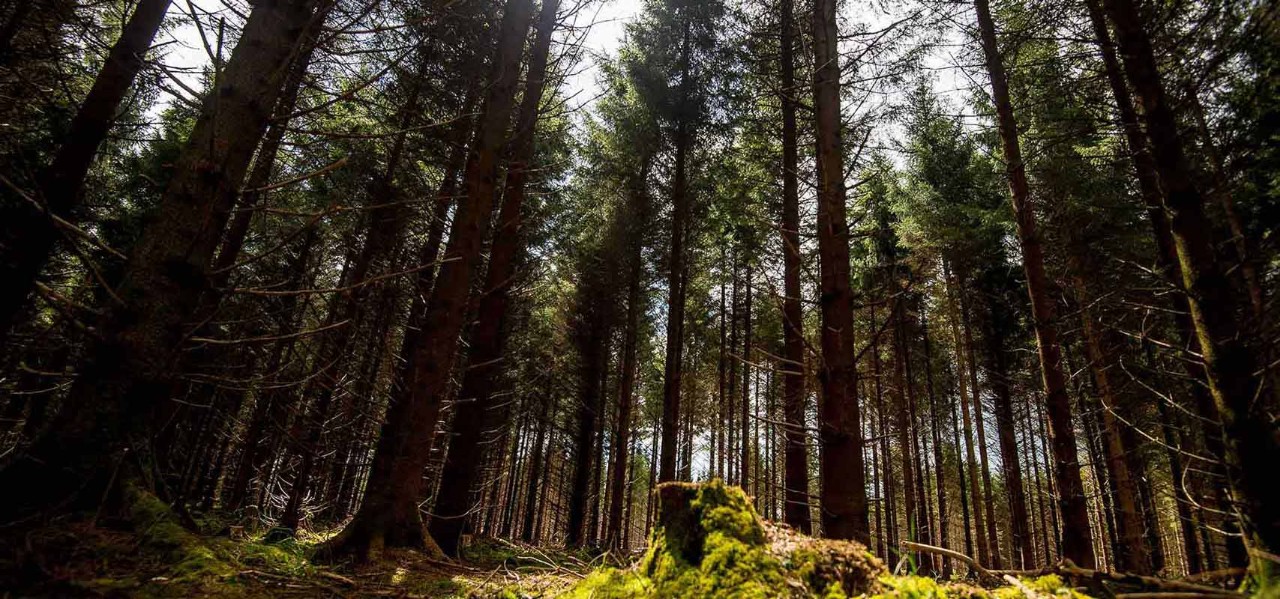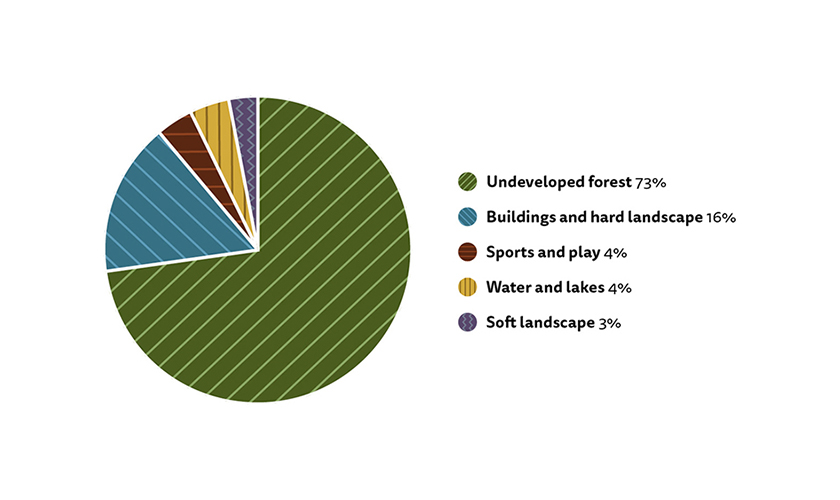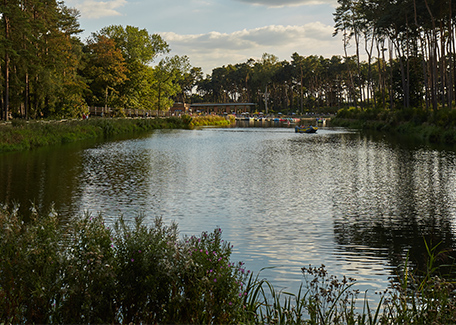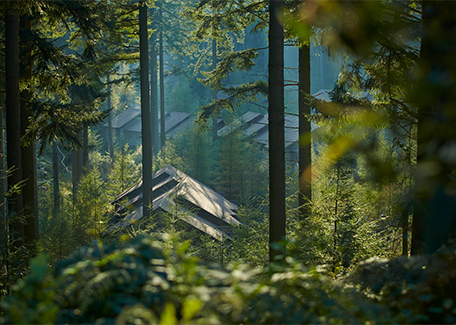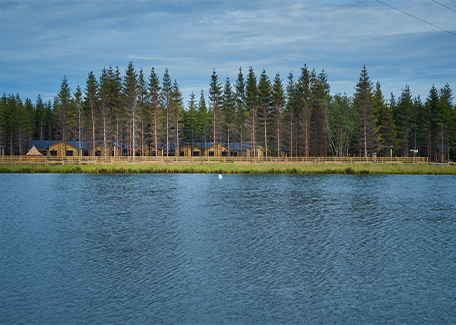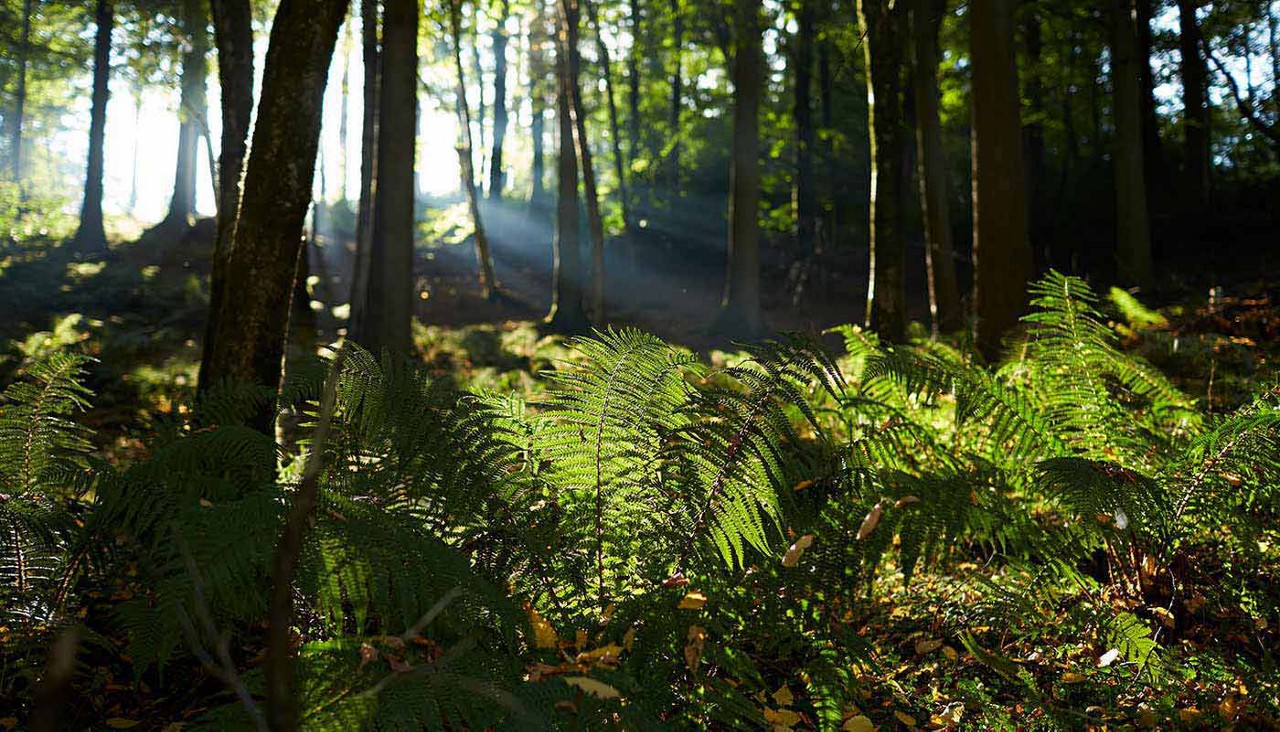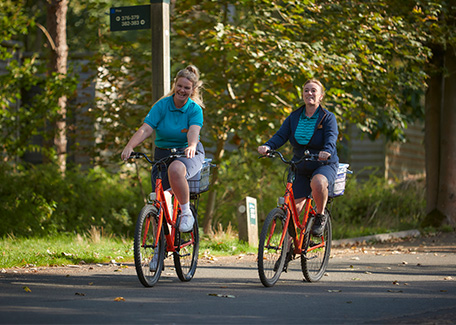Our forests define Center Parcs
Our forests are at the heart of our business and are home to many species of local and national significance. We recognise that we have a responsibility to protect and enhance our forests which provide biodiverse habitats for a wide range of wildlife. We are proud to have held The Wildlife Trusts’ Biodiversity Benchmark for over 15 years, in recognition of our efforts.
Every village has its own Forest Management Plan (FMP) tailored to the needs of each forest. This key corporate planning document includes detailed information about each of our forest settings, together with technical and specialist landscape and forestry information. It also includes data and evidence about our forests to inform business decision making and describes the contribution a well-managed and diverse forest plays in the overall success of our organisation.
Our FMPs show how active custodianship of our rich and diverse forests not only ensures a superb environment for our guests and that we meet all aspects of environmental compliance, but is also integral to achieving our wider environmental, social and governance (ESG) goals. In addition, they enable us to maintain our nationally recognised accreditations and awards.
Public interest in protecting nature and biodiversity is higher than perhaps it has ever been. A great deal of our success as a business is linked to the investments we make into the active and careful management of our biodiverse forests, ensuring that they, hand in hand with our business model, are resilient for the future.
Forest Management Plans Executive Summary
Our Forest Management Plans both enable and direct all aspects of our forest custodianship. They:
- Detail and guide the practical application of our corporate commitment: To protect and enhance our forests and their biodiversity, in line with our wider approach to ESG.
- Support our approach to climate resilience and adaptation in a changing climate: Close management of our forests is increasingly important to protect ecosystem integrity and stability and to ensure that they enhance the climate resilience of the business as a whole.
- Secure our physical brand from dilution: Ensures consistency of appearance across villages and attractiveness of the lodge setting, landscape features, materials palette across the village and forest - key components of the expected brand, anticipated guest experience and guest satisfaction.
- Include essential management information for informed, compliant decision making: Each village-specific FMP helps shape and expedite efficient, knowledge-led decisions whether for maintenance, village improvements and new facilities or accommodation development.
- Provide business critical data: Includes comprehensive data to support relationships with statutory partners, evidencing our in-depth knowledge of our forest and landscape assets.
- Contain technical and specialist know-how: Our FMPs are a ‘source book’ for information about every aspect of our forests. This adds value, as colleagues with specialist knowledge can deliver high quality services and improve our guests’ experience.
- Accurately inform financial planning to sustain our largest physical asset and valuable natural capital: Village-specific information is the basis for medium- and long-term financial planning.
- Illustrate the direct links: Between commercial success, the quality and biodiversity of environments we offer our guests, the essential elements of the forest landscape setting, built amenities - and the physical infrastructure investment needs of each village.
- Sit at the heart of key corporate compliance and accreditations: Such as wildlife legislation obligations, Biodiversity Benchmark and ISO 14001.
Environmental, social and governance (ESG) disclosures and reporting are an essential component of modern, successful and sustainable business. Our business model depends on the environment to a greater extent than many other businesses - with our land assets, our villages, our forests, our waterbodies and the ecosystems they support and sustain being central to our business operation, since our first village opened in the UK in 1987.
ESG is being driven as a priority from the top of the organisation and is identified as one of nine strategic workstreams, with Colin McKinlay, Chief Executive Officer, serving as sponsor. Refreshed ESG governance is in place at the time of publication of this plan, driven by dedicated roles in the Environment and Sustainability team, ensuring that we have the resources and structures in place to drive forward our ambitious ESG agenda.
The FMP plays an important role in this ESG governance landscape, in that it focuses on our physical assets and their environment, defines the physical ‘brand standard’ for many of our assets and maps out the custodianship commitments we have made. It translates our corporate objective for high quality physical assets, within a safeguarded and enriched environment which we have undertaken to sustain.
It goes further and maps out how we will operate with consistency across our villages, with a strong and recognisable physical brand, components which we have assessed as being central to our achievement of industry leading commercial success.
Continually enhancing the biodiversity of our forests has been a central aim for Center Parcs, since the opening of our first UK village in 1987.
Our approach as we develop our villages is to prepare accommodation platforms together with spaces for buildings, infrastructure, waterbodies, soft landscaping and facilities within the forest. These occupy just 27% of the total forest area (across all villages) with the vast majority of our forests (73%) remaining undeveloped. But even with these modest interventions, the resulting opportunities for biodiversity are dramatic and positive.
Opening up pockets, thoroughfares and glades across a previously sterile, and often mono-crop forested landscape leads to the rapid establishment of diverse pioneer species and light to the forest floor, for the first time in decades, activates dormant seed banks within the soil. Germination of a wide range of grassland, wildflower, understorey and tree species is the direct result. Even where our forest environment is already diverse, as was the case when developing Longleat Forest and after acquiring Whinfell Forest, dramatic biodiversity gains have still been achieved, albeit from a much more biodiverse forest baseline.
As our work continues, both at village development and continually thereafter, we protect and safeguard retained forest areas and actively select plant species to screen, visually ‘soften’ buildings and infrastructure and/or frame views. This includes selections of a diverse range of native species, species appropriate to each village locale, and those which will provide homes for wildlife.
Plant species selection is also informed by the extant flora and fauna within each village and consideration of this starts several years before any village is opened. Detailed ecological recording and monitoring of our forests captures baseline data on species range, habitats, species of local, regional and national significance. We cross refer to the biodiversity action plan priority areas for the local area, regionally and nationally, appropriate to the areas in which our villages are located. Work is planned to support, sustain and where possible, grow habitats and populations already present within our forests, as well as actively manage and mitigate the impact from invasive species (e.g Himalayan balsam) which are detrimental to achieving maximised opportunities for biodiversity. Proactive steps are therefore taken to enhance biodiversity and remove barriers to increasing biodiversity within our villages.
The management information captured within each FMP provides a platform for a significant level of contemporary data to be actively used in shaping business decision making on each village. This information includes our Asset Summary plans - detailed drawings which provide an accurate overview of the physical assets on each village: what, where and how much (area). When planning any initiatives within a village, the Asset Summary is used to give a comprehensive overview of the current village environment.
Whilst the creation of a Center Parcs village is not strictly formulaic, the cornerstones of our physical brand are consistent across villages and these are mapped on each village Asset Summary, include the proportion of developed and undeveloped forest, guest facilities/accommodation and key landscape components (such as water and play areas).
The management information captured within each FMP provides a platform for a significant level of contemporary data to be actively used in shaping business decision making on each village. This information includes our Asset Summary plans - detailed drawings which provide an accurate overview of the physical assets on each village: what, where and how much (area). When planning any initiatives within a village, the Asset Summary is used to give a comprehensive overview of the current village environment.
Sector leading family short breaks, within a forest environment, is our unique offer. We recognise however that our forest setting brings additional expectations and obligations, which non-forest-based businesses may not have to consider. Meeting these additional obligations, as we plan village developments and run our day-to-day business, are distinctive features of our continued successful operation within a forest environment. These obligations are evolving, recognising the impacts of a rapidly changing climate.
Compliance with these obligations, indeed meeting and exceeding these is part of our mandatory corporate approach. Special and detailed consideration, including advanced investment where needed, is duly given to works which can in any way impact our forest trees, protected species, protected habitats and existing statutory conditions/consents or requirements already in force.
We recognise that Local Planning Authority partners often impose lasting obligations when we develop our sites, both at initial village development and as part of new projects. These obligations may persist for fixed time periods, or (often) permanently. At the time of publishing this plan, planning obligations are continuing to broaden, for example with the introduction of ‘Biodiversity Net Gain’ obligations in late 2023 and into 2024.
Successful operation of our business goes further than compliance, however. We are committed as an organisation that, if we can do the right thing, then we should. Protecting, safeguarding enriching and sustaining our forests are all actions which are central to our unique business model. We are proud of our far reaching, sector-leading environmental achievements and remain ambitious in our goals to continue to lead the way for our industry and others.
We recognise that our role as forest custodian is a long-term role, and that these living, dynamic environmental assets - together with the ecosystems of flora and fauna that they support, have a productive and valuable life which will span many human generations. We therefore are also alert to the future long term needs of the forest – and consider these as both a stewardship obligation and an intrinsic commercial success factor for Center Parcs.
Our forests are not static - and nor are they (any longer) commercial ‘crop’ forests - which had been originally planted for rotational high growth phases followed by periodic clear felling. Having developed our villages primarily within initially sterile commercial forests, this would have been the expectation for our forests before our ownership began.
Our model is different. Forest renewal is ‘designed in’ to our approach, with continuous canopy cover, biodiversity and natural regeneration being our goals, where the forest is encouraged to renew both naturally and with considered planting. We also work to diversify the plant species within our forests so that they in turn can support an ever-diversifying community of plants, animals, insects and fungi. We do this as we progressively migrate our ‘commercial crop’ forests, with investment, careful stewardship and time, into biodiverse, sustainable, safeguarded and enhanced forest environments.
Our FMPs support an approach which ensures that future forest planning can take place proportionate to the scale of the forest, its age and its whole-time life-span. This long-term, strategic planning for our forests is in fact an integrated part of all our business and development project delivery. To illustrate how this works in operation, we can refer to our forest matrices. These are typical landscape layout schematics which have been prepared for each accommodation type, which are used to specify and budget for mitigation works prior to major accommodation refurbishment, plan annual forestry thinning operations and improvement work (without intensive detailing), maintain brand standards when developing new initiatives and share knowledge across the business about the identified landscape objectives in different areas of our forests.
This detailed, advanced planning ensures the appropriate emphasis and key budget provision for the forest environment – as a focal objective in all our work. Our ability to reinforce the integrity of the forest underpins our business success strategy and enables timely budgeting for essential external works as well as ensuring biodiversity safeguards and forestry enhancement, as an integrated part of each and every Center Parcs village operation.
As part of the development of the FMPs, we have engaged our colleagues fully, worked with volunteers who support us in our work and sought to secure the input of external statutory bodies and stakeholders. This has been achieved through a range of update and discussion meetings throughout the course of the review process in 2022 and 2023, which builds on the engagement undertaken through earlier reviews.
For this full review, engagement was detailed and extensive. It included:
- Grounds Services team discussions and engagement throughout the development process
- Dedicated Nature Conservation Ranger workshop
- A series of individual, village based workshops, with feedback to wider teams
- Head Office FMP sessions for non-village based teams.
- Dialogue and engagement with village and local stakeholders by email and online survey
Further strategic stakeholder engagement through participation in a Center Parcs-led webinar event.
Many of our partners have been central to the approach and helped to inform the FMP review process, alongside colleagues from every part of our business. Our thanks and gratitude for the valued input of all our partners is acknowledged.
Our FMPs comprise a suite of six village-specific documents, published in 2023. They fully update and replace our 2012 Forest Management Plan series.
For each village, the Forest Management Plan:
- Clearly articulates our forest-led business model
- Introduces the FMP development, publication, management process and contents - in detail
- Highlights the achievements over time including biodiversity gains, landscape improvements, forest species diversification and enhanced guest amenity from our forests
- Supports the highest quality, compliant business operation within our forest settings
- Sets out our ambitious biodiversity action plan and performance indicators for the same
- Provides a framework to maintain and actively reinforce the design integrity of the Center Parcs physical brand
- Captures key site specific and business-wide narratives on heritage features, water management and sub-tropical planting
- Provides current and comprehensive data on our forest assets, attributes and amenities
- Sets out how colleagues are and continue to be involved in FMP production and delivery, including sharing environmental and forest insights and experiences with our guests
- Informs the investment strategy for revenue and capital expenditure
In addition, building on the work undertaken in 2011-2012 during the development of these plans, every landscape aspect of each village has been reviewed, to quantify, record and map its individual portfolio of physical assets. Information has been gathered and assessed to give an in depth understanding of each village, which is thereafter maintained by the Grounds Services teams on each village.
The FMP, along with supporting financial data, brings together the annual investment needs of the forest, informing the long-term investment plan. Cyclical capital investment needs, such as individual village exceptional overheads, major replacement works and periodic refurbishments, are informed in turn by the completion of condition surveys (e.g physical audits providing budget estimates) and by competitive pricing exercises - sought periodically for a range of our standard construction details. Future budget indications also draw on relevant recent quotes for tendered works, supplemented with historic patterns of spend / estimation.
This approach gives the resulting financial framework which is in place to support the FMPs a demonstrable robustness. However, active ongoing management and updated costing exercises are also an important part of the process to maintain contemporary financial forecasts, moving forward.
As described, specific financial and investment needs have been generated and allowed for within our corporate financial planning processes.
In addition to this investment requirement, the internal resource requirements are generalised though not specified - for instance, staffing complement is shown but not costed. The FMPs consider technical knowledge, training needs and the skills required to implement the FMPs with a focus on forestry, nature conservation and landscape operations.
The FMP for each of our villages across the UK and Ireland, proposes a clear forward strategy for the village, driven by an overt corporate ambition to sustain and invest in our forests.
In order to remain ‘live’, the FMP requires and receives annual updating and periodic refreshing to ensure that the village content stays both accurate and robust. This is a shared responsibility, overseen by the Environmental, Social and Governance (ESG) Committee, sponsored by our Chief Executive Officer, led by the Director of Sustainability, with operational management delegated to the Forest Asset Manager, in partnership with the village Grounds Services Manager and village team.
The Forest Management Plans also sit at the heart of the work of the corporate ESG Committee. This group, alongside the Risk Committee, is responsible for ensuring that climate-related risks and opportunities are managed within all business operations. The ESG Committee reports to the Center Parcs Operating Board on a quarterly basis and is chaired by our Chief Executive Officer. The ESG Committee reviews and approves all organisational ESG related plans and strategies and reviews progress and performance against associated ESG targets and KPIs. The ESG Committee have delegated the day-to- day management of ESG matters, to an ESG Working Group.
